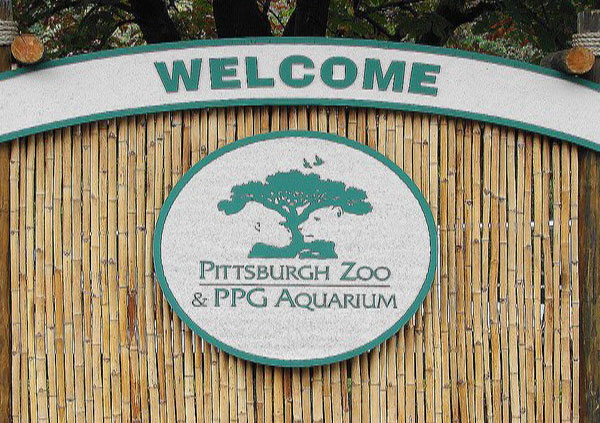By Nicole Miller serving with The Penn State Center for Sustainability: Pittsburgh

This past month while serving with Penn State Center for Sustainability: Pittsburgh, I had the unique opportunity to assist in a sustainability assessment for the Pittsburgh Zoo and Aquarium. As a teaching institution, the zoo has the ability to use solar and green roof installations for education as well as for energy usage. This presented a challenge as the suggested areas had to be visible to the public as well as practical.
In the case of the solar panels, this means that not only did the roofs need to be facing south, but also visible from the visitors vantage point. In order to assess whether a roof would be optimal for solar installation, we used a solar eye (pictured below on the right). This is a basic tool that solar contractors will use. It measures how much sun a solar panel would receive based on historical data, direction facing and location.

While there were few buildings facing true south, advancements in solar technology made it feasible to suggest other options. In particular, solar panels can be used to double as greenhouse roofs and let much needed light into the building. This is done by expanding the space between individual cells and using a clear glass instead of metallic backing. Conversely, solar panels could be installed in are-as in need of shade, gathering unwanted light. Both of these innovations could be used to maximize the usefulness of the panels.

Another portion of the sustainability assessment included scouting potential locations for a green roof. The benefits of a green roof system include: reduction of cooling and heating loads, increased building insulation, storm water runoff reduction, and the creation of green space. The Pittsburgh Zoo and Aquarium already has one green roof installation. However, the roof is neither accessible nor visible to the public. Therefore, the educational value of the roof is currently minimal. For the Zoo to maximize the potential educational value in a green roof system, they need to consider adding a roof in a visible location. Because green roofs need a flat surface and most flat roofs are not easily seen from the ground, we searched for small lodges, exhibits, etc. that could house the green roof.
I feel very fortunate to have had this experience. It demonstrated the creativity necessary to make sustainable improvements that align with design and use on preexisting structures . I am thankful to Scalo Solar Solutions for allowing me to participate in this experience, and wish the Pittsburgh Zoo and Aquarium the best of luck in the greening ventures!

Nicole Miller is a native Pittsburgher, Nicole is excited to return home and serve as an EnergyCorps member. After graduating from Denison University with a degree in environmental studies and religion, Nicole spent time on the west coast teaching outdoor education. Having previously worked to develop environmental education programs, she understands the challenges facing both educators and environmentalists. Nicole is ready to serve with The Penn State Center and hopes to offer her experience and energy to the program.







